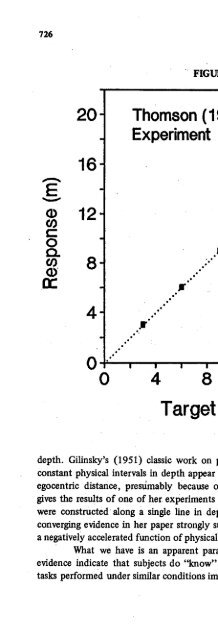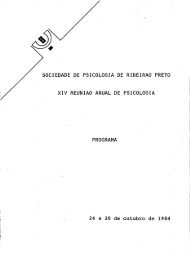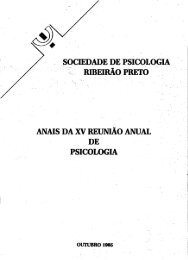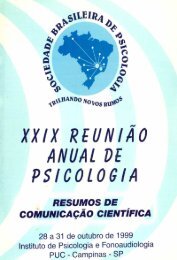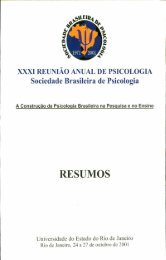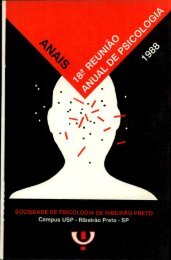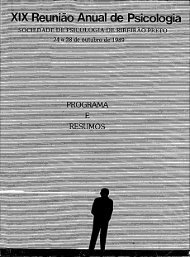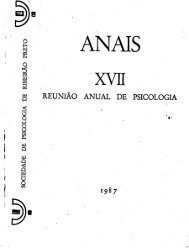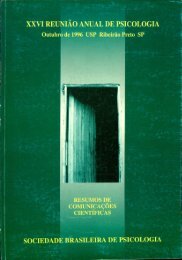- Page 1 and 2:
* * ê v @ @ . . . / ** * + * - ï*
- Page 4:
Souza. D.G.; Otero. V..R.L.; Biasol
- Page 8:
COORDENADORES DE DIVISGES ESPECIA L
- Page 12:
SOCIEDADE DE PSICOLOGIA DE RIBEIRAO
- Page 16:
slM slo: 1. Neurobiologa da Aprendi
- Page 20:
8 . A plicaçöes da metodologa obs
- Page 24:
- Reûexöes sobre o trabnlho. femi
- Page 28:
' 8. A formaçïo e o treinamento d
- Page 32:
6. Fato, valor e Gignificado em Psi
- Page 36:
ED ITO RIA L 2 com satisfaWo que pa
- Page 40:
û* SEV AO INAUGURAL DA XVIll REUNI
- Page 44:
4 Por flm , a conscidncia de que é
- Page 48:
6 Com a palavra, Mara lgnez Campos
- Page 52:
, #' 8 . ' m ssoal que on ' b a par
- Page 56:
10 assodaçses de psicolo#a existen
- Page 60:
12 ajuda, sem o que teda sido impos
- Page 64:
' 14 -xA Tenho me batido, como söc
- Page 68:
W O RKSHOP 1 AVANCOS RECEM ES EM AN
- Page 72:
' 20 Um némero crescente de estudo
- Page 76:
' 22 Mas as classes de estfmulos eq
- Page 80:
24 evidenciado por infralm manos. A
- Page 84:
26 Depois que os sujeitos aprendera
- Page 88:
28 a determinados adjetivos em resp
- Page 92:
30 como modelo). Os resultados de d
- Page 96:
32 . Silverman, K., Anderson, S.R.,
- Page 100:
M Os pesquisadores que procuravam g
- Page 104:
36 Acho que a pande mudança no uso
- Page 108:
38 infonnaWo, usando a t/cnica da c
- Page 112:
40 4* la G l u' n Q C 2$ f I , ta (
- Page 116:
42 (n @ * c k n * m < = @ ' * 4=.-,
- Page 120:
fqt= ...1 ,' .D f.pel = 10 LL M* 1
- Page 124:
46 œ to fn D u l m tI7 œ , * 1:13
- Page 128:
48 A idéia bésica consiste em pro
- Page 132:
50 Nedn, J.A. (1988). Behavioral Mo
- Page 136:
52 permitir inferdncias sobre o m o
- Page 140:
M 23.Branch: M.N. - Behavioral plmr
- Page 144:
56 De 1lm modo bastante geral, pod
- Page 148:
58 mentos envolvendo a participaçZ
- Page 152:
disruptivo do choque na seqûéncia
- Page 156:
62 preferdncia por llma explicaçâ
- Page 160:
' Boles, R.C. (1970). Species-speci
- Page 164:
COMPORTAMENTO INDUZIDO POR CONTINGE
- Page 168:
mos restritivamente às caracterfst
- Page 172:
precisamos ser especialistas em com
- Page 176:
W O RKSHOP 2 FAMILIA:PESQUISAS CöM
- Page 180:
76 Realizada no perfodo de agosto d
- Page 184:
78 f no exercfcio da dinâmica entr
- Page 188:
88 Sob pressâo das espos% , que re
- Page 192:
82 A pesquisa com fnm lias de dois
- Page 196:
em aula: 1) discusGes sobre Nat x C
- Page 200:
86 nificativos neste sentido. A neg
- Page 204:
O CONCEITO SOCIOLUGiCO DE FAMIYIA:
- Page 208:
EM BUSCA DA PA RCEIRA SILVIAMARm A
- Page 212:
obstâculos à infidelidade. A conf
- Page 216:
FAMIYIA E PRATICAS DE EDUCACAO DA C
- Page 220:
' i . 97 ( i . i . ) o jovem çse e
- Page 224:
conduta e de concepçâo nas pritic
- Page 228:
O PROCESSO DE MODERNIZACAO DA SOCIE
- Page 232:
103 Este é o caso particulnrmente
- Page 236:
105 Em outras palavras, foi exatame
- Page 240:
107 Nicohcida-cosu, A.M. (1988a). B
- Page 244:
MEMORY IN HONEY BEES RANDOLF M ENZE
- Page 248:
. 113 impbrtantly, 3 sensitization
- Page 252:
trace of the first conditioning tri
- Page 256:
118 smdal set of pnmary colours (Ba
- Page 260:
120 M mpestris are maximnlly sensit
- Page 264:
OPPO NENT CO LO R COD ING A ND CO L
- Page 268:
5 Smlm* g of color sl-m lnrlty il l
- Page 272:
CO LO UR CONSTANCY IN TH E HO NEY B
- Page 276:
Violet Colours: ' ' In the first ex
- Page 280:
131 over these plates. n erefore, t
- Page 284:
slkpôslo 2 NEUBIOX IA DA APXENDIZA
- Page 288:
136 to t im e colzrse, tlrezold , s
- Page 292:
138 the reverse of adaptation, both
- Page 296:
V ISUA L SYSTEM O F TH E BEE: LAM I
- Page 300:
143 of the normalized intensity fun
- Page 304:
145 Menzel, R. (1974). Sm ctral sen
- Page 308:
l48 jy t deuto. nervous system of t
- Page 312:
150 SOG. So far, the behaviour o'f
- Page 316:
PHA RMA CO LOG Y O F LEA RNING A ND
- Page 320:
155 in retrie (14). Upon local inje
- Page 324:
ACKNOWLEDGEMENTS 157 I am pateful t
- Page 328:
INTRODUCAO AO TEMA DE DESNUTRICAO E
- Page 332:
INTERFERENCIA DE FATORES NUTRICIONA
- Page 336:
165 dos para leitura do esqueleto,
- Page 340:
167 nossos resultados neste sentido
- Page 344:
170 O peso corporal dos ftlhotes pr
- Page 348:
PERSONALIDADE, PADROES COMPORTAMEMT
- Page 352:
175 Wo entre situaç& s de perda e
- Page 356:
177 O estado depresivo tanto altera
- Page 360:
Refe/ndas 179 M exander, F. Psychos
- Page 364:
' 182 no d eve sem'pre se encam ir
- Page 368:
184 como unificado, provdm da confr
- Page 372:
186 seus seios (4çera normal' t4er
- Page 376:
' 188 svelam uma auséncia de integ
- Page 380:
SIMPôSIO 6 ENVELHECER NO BRASIL -
- Page 384:
194 Quadro 11 - Faperança de ' An
- Page 388:
196 Idade, mesmo as constantes tent
- Page 392:
198 . entre nmbos proporciona, é v
- Page 396:
A QUESTAO DO ENVELHECER COMO UM PBO
- Page 400:
' 2Q3 . . se vedm pouco. As esparsa
- Page 404:
AVANCOS E PROBLEMAS NA DEFINICAO DE
- Page 408:
' ESTUDO D E CASO D E UM A M U LHER
- Page 412:
209 södo-interadonista para essas
- Page 416:
2l1 M ëm disso, conhece mflsicas,
- Page 420:
213 ' HallpAe, C.R. 1979. n e Found
- Page 424:
A HOSTILIDADE COMO REK AO ADAPTATIV
- Page 428:
Refeëndas'. 219 Alcock, T. (1956).
- Page 432:
222 2. Na ltistöria da antropolosa
- Page 436:
A INTERPRETACAO PSICANALIYICA D0S T
- Page 440:
227 de asodalo livre modilkada', a
- Page 444:
229 bn- na teoria das relaWes oblet
- Page 448:
NovAs BAsEs PARA INTERCAMBIO UNIVER
- Page 452:
235 a conœpWo de que os Proflssion
- Page 456:
237 M anha, J.MA 'tDocumento' melim
- Page 460:
240. . . educacionais, t-sm afastad
- Page 464:
A REALIZACAO DE ESTUDOS VOLTADOS PA
- Page 468:
245 sala-dt-aula, quxis os fundamtn
- Page 472:
247 Nidelcoff, M.T. (1978). Uma ert
- Page 476:
250 hnmento' de métodos de alfabet
- Page 480:
REFLEXöES SOBRE A METODQLOGIA OBSE
- Page 484:
255 usadas para aceitawo no pupo, a
- Page 488:
SISTEMATIZACAO NA AVALIACAO DE DIFI
- Page 492:
PROCEDM U O 259 Para levar a efeito
- Page 496:
261 ' Qlmndo a criança n:o produz
- Page 500:
) Troca 263 Ao escrever a criança
- Page 504:
265 ' . . maçâo de atividades que
- Page 508:
.M 8 ' . . ' ' . ' ' Assim kendo,
- Page 512:
270 ii scutida. InferHcias devem, p
- Page 516:
272 comportamento. A m rtir daf, an
- Page 520:
274 ANEXO 1 FOLHA DE OBSERVACAO EM
- Page 524:
m XO 3 . lDl1E DO ALUNO: DATA: / /
- Page 528:
INSTRUMENTO DE OBSERVACAO DA INTERA
- Page 532:
NOME: NO. de Identicalo: Data: Hora
- Page 536:
A FORMACAO DE PESQUISADORES EM EDUC
- Page 540:
287 seu orientador oconia q'lnKe se
- Page 544:
289 tirzo constatar se os objetivos
- Page 548:
292 (, . . . . . . . : ' atados Ulu
- Page 552:
294 Refe/nm-nm: . : . M en, V.L. Ch
- Page 556:
296 de Defidentes da Audiocomunical
- Page 560:
298 criarem condiçöes mais favori
- Page 564:
UM A ABORDAGEM ERGONOM ICA DO MOBIL
- Page 568:
. 303 diferentes, 1lm tradicional e
- Page 572:
306 analise a infludncia de mnnipul
- Page 576:
* 8 creche. Em geral os dados obtid
- Page 580:
31: Proshansky, H.M .; Ittelson, W
- Page 584:
ALFABETIZACAO E PROBLEMAS DE APREND
- Page 588:
ENSINO DE LEiTURA PARA CRIANCAS COM
- Page 592:
317 incentivado a partidpar e, dln
- Page 596:
319 Um dos resultados simultlneos
- Page 600:
322 Refeëncias Berruecos, M.P. - L
- Page 604:
hkodulo: PROBLEMAS EPISTEMOL;GICOS
- Page 608:
327 ko caso da Psicolo#a Organizado
- Page 612:
329 sutil prâticas que sugerem pre
- Page 616:
331 A contradiçâo é aqui revelad
- Page 620:
PSICOMETRIA E SELECAO DE PESSOAL MA
- Page 624:
335 Em sfnteses o paradim a da psic
- Page 628:
337 b) Uma vez realizada neste cont
- Page 632:
M Q A avalialo de necisidades t um
- Page 636:
342 rem modificaçöes no smbiente
- Page 640:
M 4 Lima, S.M.V., Borges-Andrade, J
- Page 644:
346 No procedimento de utilizalo da
- Page 648:
M 8 Flanagan, J.C. (1954). The Crit
- Page 652:
O M OV IM ENTO PELOS D IREITOS HU M
- Page 656:
353 Os Direitos Hllmanos passam a s
- Page 660:
VIOLENCIA NO CAMPO: UMA ANALISE DOS
- Page 664:
357 dos camponeses, e nIo am nas os
- Page 668:
SIMP;SIO 14 A BUSCA DE IDENTIDADE -
- Page 672:
362 Sabemos, da antropologa, que em
- Page 676:
364 da Izi, no Pflblico ou no priva
- Page 680:
' ' 366 homem econômico ou polfdc
- Page 684:
368 ' . . t . No caso dos homossexu
- Page 688:
370 n:o se reladonarnm com mlxlhere
- Page 692:
O IDOSO E A IDENTIDADE DETERIORADY
- Page 696:
375 Conlitos entre geraçöes esuo
- Page 700:
SIMPôSIO 15 OS ASPEW OS ORGANR ATI
- Page 704:
380 que eles estlb ajudando a com l
- Page 708:
382 bloqueio e outro abnivo assinad
- Page 712:
384 atenWo para a variedade de form
- Page 716:
386 *&Eu rfnàa muîta /kcflfo le d
- Page 720:
388 sociais, ë de que estes n:o oc
- Page 724:
390 vanas, acampsmentos junto às a
- Page 728:
CONSIDERAX ESSOBRE M PECTOS MICRO*X
- Page 732:
395 . g) o lzso dos preconceitos e
- Page 736:
SIMP;SIO 16 SIMIG IO INTERDISCDLm A
- Page 740:
400 Com relaçâb ao capftulo refer
- Page 744:
402 tos, sem falar na sdrie de deba
- Page 748:
' SOBRE A QUESTAO DASUBJETIVIDADE E
- Page 752:
407 a subjetividade, nessa segunda
- Page 756:
Re f e-- ztl AR ' Freud, S. (1935).
- Page 760:
412 claro, o fmico significado resp
- Page 764:
414 descrito, para alëm das versö
- Page 768:
416 postas entre , tais eventos t6m
- Page 772:
' . COM PO RTA M ENTO , SUBJETIV ID
- Page 776:
421 de subjetividade cujo fundament
- Page 780:
423 liznitado, ou por causa da inex
- Page 784:
4;5 revelados nâb' sö imediatnmen
- Page 788:
Refe/lzztllm: 427 Boring, E. A Hklt
- Page 792:
CONSIDERACOES SOBRE A UTILIZACAO D6
- Page 796:
433 E claro que os indicadores da T
- Page 800:
435 mental entre nös é a ênfase
- Page 804:
PsIco LoG lA CO M PA RATIVA I CESAR
- Page 808:
439 Watson (1914) alimenta 1xm entu
- Page 812:
e 1 Tomarei, como outro exemplo, as
- Page 816:
* 3 A recuperaçâo se nota por div
- Page 820:
G fee das e 5 Ades, C. (1965). Comp
- Page 824:
* 8 . ' . ' . . '. ' creveram no pe
- Page 828:
450 da Vérzea do Calp o'' e ali im
- Page 832:
452 M as sua proposta B foi atendid
- Page 836:
454 Talvez a érea em que mais se r
- Page 840:
M ESA R EDON DA 3 PUBLICAG O CWNTPI
- Page 844:
46e : q:. Quadro 1 - Continuaçïo
- Page 848:
PROPOSTA PARA A SISTEMATIZACAO E DI
- Page 852:
465 As Sociedades espedG zadas pare
- Page 856:
M ESA REDONDA 4 CUIA ,UMA PROO STA
- Page 860:
470 d) Ciclo profisional opcional -
- Page 864:
CURRIQULO:REFORMA OU TRANSFORMACAO
- Page 868:
+ < Tabela 1 - Freqidnda dà utiliz
- Page 872:
Tabela 2 - Relaçâo dos projetos d
- Page 876:
* Tabela 3 - Agrupamento dos objeti
- Page 880:
O CURR CULO DE PSICOLOGIA NA UnB M
- Page 884:
483 estrubxu, tratou-se de organiza
- Page 888:
M ESA REDONDA 5 ABORDAGENS QUALITAT
- Page 892:
488 gem social trouxeram lxma p and
- Page 896:
490 consigo toda a sua bagagem de v
- Page 900:
492 tativa Gextrai'' do m squisador
- Page 904:
494 qlmntitativo) ou por usarem të
- Page 908:
496 concepWes comxmg quanto a valid
- Page 912:
498 de condiçöes sociais e teödc
- Page 916:
500 lhadas, a anélise' deve consid
- Page 920:
502 ' . ' . que procm adar conta da
- Page 924:
504 caracterfsticas (lingifsticas,
- Page 928:
Q UA IS OS O BJETIVOS DA PESQ UISA
- Page 932:
509 complexos, prë-conceitual e co
- Page 936:
ALGUMAS REFLEXOESSOBRE O USO DA CAT
- Page 940:
513 . critério de recorte que just
- Page 944:
Referências: 515 Branco, A.C.U.A.,
- Page 948:
518 ritmo, etc.) e nâb vocais (ges
- Page 952:
520 compatibilizar a lögica do sis
- Page 956:
VIVENCIAS RELATIVAS AO TRABACHO EM
- Page 960:
525 Enfrentnmos, decerto, ainda mui
- Page 964:
528 que o psicölogo a reconhecesse
- Page 968:
530 ' go em psicodiar östico, o qu
- Page 972:
A IMPORTANCIA DO LAUDO MONIQW AUGM
- Page 976:
536 mento e sua habilidade técnica
- Page 980:
M ESA REDO NDA 8 A FORMACIO E O TRE
- Page 984:
542 dual ou grupal, criança, adole
- Page 988:
' O EU, O OUTRO E O MOVIMENTO EM FO
- Page 992:
547 Esta atençâo vivida no acompn
- Page 996:
549 compreender o fenômeno. mas ao
- Page 1000:
552 abarcar todo o campo de conside
- Page 1004:
554 Em resllmo: acredito que, com o
- Page 1008:
O ADOLESCENTE COMO ALVO DE ATENCAO
- Page 1012:
AQOLESCENTES EM GMUPO DE REFLEXAO.
- Page 1016:
REqEXCES SOBRE UM PROGRAMA DE ORIEN
- Page 1020:
M ESA REDO NDA 11 A FORMK âO IXI T
- Page 1024:
568 - Clzrfculo Mfnimo Obrigatörio
- Page 1028:
570 JJ Clnstpcaçwo Esta classifica
- Page 1032:
572 mernmente burocrâtica. Com rel
- Page 1036:
M ESA REDO NDA 12 TERAPIA O MD RTAM
- Page 1040:
578 ' Se necessirio, faço entrevis
- Page 1044:
580 eram de atendimento da criança
- Page 1048:
ANALISE COMPORTAMENTAL DA DOR ANTON
- Page 1052:
585 como de sua famflia. Os profiss
- Page 1056:
UMA VISAO DESCRITIVA % PSICODINAMIC
- Page 1060:
' 5!9 poucos meses mudanças nos co
- Page 1064:
592 depressâb como m oderador, sem
- Page 1068:
594 intem ados até se esgotarem os
- Page 1072:
AVALIACAO cLlNlch DA 6oR Prof.cAktD
- Page 1076:
599 econômicos, de rfpida administ
- Page 1080:
* 1 13.Melzack, R. The short-ftwm M
- Page 1084:
INTRODUCAO AO TEMA PA SITUACAO DA A
- Page 1088:
* 7 Temos tambdm nesta mesa a prese
- Page 1092:
SITUACAO DA AIDS NO BRASIL: ASPECTO
- Page 1096:
613 fn-r quando a situaçfo tiver a
- Page 1100:
0 PAPEL D0 PSICôLOGO NA PREVENCAO
- Page 1104:
619 recursos que a. comunidade ofer
- Page 1108:
62l da criatividade tdm conseguido
- Page 1112:
d 624 quecim ento da personalidade,
- Page 1116:
A PREVENCAO DAS DIFICULDADES DE APR
- Page 1120:
629 A dcsinformalo sobre o que cons
- Page 1124:
M ESA REDONDA 16 0 PAPEL D0 SOCIALN
- Page 1128:
634 ao enfatizar a semelhança entr
- Page 1132:
636 ucödigo restrito'' d o que pre
- Page 1136:
638 palavru do autor, que tanto na
- Page 1140:
' estrutura hierfrquica mais normat
- Page 1144:
* 2 trfnsecnmente contraditöria -
- Page 1148:
' 1. Introàuction SéALING oF JUDG
- Page 1152:
5.S-l1ng of judm ents in nnlmnl œl
- Page 1156:
SOBRE A IDEIA DE FATO EM PSICOLOGIA
- Page 1160:
653 'M étodos predsos ro uma eoadf
- Page 1164:
655 to ou teoria. E entâo o exerci
- Page 1168:
CURSO 14 O ICOIDGIA SOCIAL HTQUESO
- Page 1172:
660 conjunto de princfpios estabele
- Page 1176:
662 colocados os objetivos da pesqu
- Page 1180:
CONFERENCIA 4 EXPERIMENTAjAO coM SE
- Page 1184:
668 . ' apenu prejudicar sâo proib
- Page 1188:
670 O tlso de voluntârios exige m
- Page 1192:
672 ka pesquisa. Nâo h; dlividas d
- Page 1196:
674 abusivas, que provocam o repûd
- Page 1200:
O ENSINO FUNCIO NA L DA LINGUAG EM
- Page 1204:
679 mo de provamaWo ativa para gene
- Page 1208:
V 1 se houver uma exposiçâo atrat
- Page 1212:
683 Hnlle, J.W.; Mnrsllal, A.M. e S
- Page 1216:
CONFERENCIA 8 o PRocRsso DE m ow m
- Page 1220:
688 como descreve W-llhein, 1988. M
- Page 1224:
690 inveja, de suas intrigas, de se
- Page 1228:
CONFERENCIA 10 0 DESAFIO DA ORIENTA
- Page 1232: 696 importante, Wsto que Szondi, md
- Page 1236: 698 P: o fösforo. S: o enxofre. E
- Page 1240: 7:0 inclinaçöes e necessidades lh
- Page 1244: 7Q2 G: BUSQUE APROXIMARXSE DO ESPX
- Page 1248: ALGUMAS CONTRIBUICGES DE MELANIE KL
- Page 1252: 707 ainda estâo presentes no mundo
- Page 1256: 709 como tlma hipötese algo f'los
- Page 1260: 711 A posiWo esquizo-pnmndide, send
- Page 1264: CONFERENCIA 16 CO- RTAMEM 'OS AW OV
- Page 1268: 7l6 blema para as pessou qte observ
- Page 1272: 7l8 . ' H'i virios fatov fuiol6gcos
- Page 1276: 720 atunm exige lma observaçâo cu
- Page 1280: CONFERENCIA 17 O r ROLOF O O MOTION
- Page 1286: FIGURE 2 *- @ :IAG < . .!12 > * =W
- Page 1290: = @- RN c q) O 2 W idh . 1 . o m 1
- Page 1294: E * c O c * FIGURE 7 1 . 1 .. . rl
- Page 1298: ABERTURA H ENCONTRO NACIONAL DE INS
- Page 1302: ' 734 responsé#eis mla formalo de
- Page 1306: DlvulrAçlo DE CONM GMENTO NA CI'NC
- Page 1310: 740 ' N . . . . ' . . . Tabela 1 -
- Page 1314: Tabila 3 e Atiddades das 10 ëtimas
- Page 1318: Tabela 4 - Continuaçâo NO de NO .
- Page 1322: 746 Quadro 1 - Simpösios, mesas re
- Page 1326: 748 Quadro 1 - Continuaçâo 2. Ses
- Page 1330: 750 taçâo de trabalhos programado
- Page 1334:
Tabela 8 - Distribuiçâo das comun
- Page 1338:
-4 + Tabela 8 - ContinuaWo. % em re
- Page 1342:
756 e por 10% da produçfo po pafs
- Page 1346:
SUPLEM ENTO DOS ANA IS DA Xvll REUN
- Page 1350:
762 ' ' > ' ' . ' ' . tida por Quir
- Page 1354:
764 As trls primeiras quettöes dev


